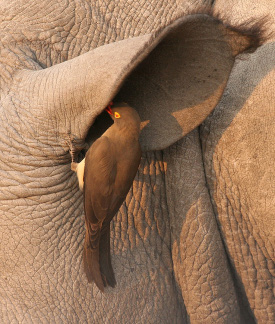Red-Billed Oxpeckers and Black Rhinos
Air Date: Week of June 12, 2020

Two oxpeckers perch atop the head of a Black Rhino. (Photo: Wendy, Flickr, CC BY-NC-ND 2.0)
Oxpecker birds are known for riding on the backs of large mammals, feeding on the ticks and parasites that would otherwise plague their hoofed companions. Now, research indicates that oxpeckers may also help rhinos by acting as an early-warning system when they sense danger. Living on Earth's Don Lyman has the story.
Transcript
LYMAN: Red-billed oxpeckers are a species of bird that lives in the African bush. These eight-inch-long brown birds with distinctive red bills and yellow-ringed red eyes can often be seen riding on the backs of large mammals, including giraffes, Cape buffalo, and endangered rhinos, where they feed on ticks and other parasites on the animals’ hides.
But new research reveals that the oxpeckers’ symbiotic services extend beyond parasite removal. Rhinos have very poor vision but oxpeckers can see exceptionally well and issue a shrill alarm call which can warn the rhinos of potential danger.
Researchers in the study approached 11 black rhinos by foot on the open plain on 86 occasions. They found that rhinos with a red-billed oxpecker on their backs were much better at detecting the researchers’ presence than those without an oxpecker.
Rhinos without oxpeckers on their backs were able to detect the scientists approaching only 23 percent of the time, but rhinos with oxpeckers detected the scientists 100 percent of the time. The researchers also reported that rhinos listening to an oxpecker’s alarm call picked up on the approaching scientists from 61 meters away, more than twice as far as when there were no oxpeckers with the rhinos.

A red-billed oxpecker near a rhino’s ear. (Photo: Brian Scott, Flickr, CC BY-NC-ND 2.0)
All the rhinos they observed responded to the oxpeckers’ alarm calls by becoming more vigilant — they stood up if they had been resting — and turned to face downwind. Then the rhinos either ran away or walked downwind to investigate the potential danger.
Black rhinos where at one time the most numerous species of rhino in the world, but poaching for traditional Chinese medicine has resulted in black rhinos becoming critically endangered. Only an estimated 5,500 black rhinos remain in the wild.
Red-billed oxpeckers numbers have declined as well because of pesticides used to kill parasites on domestic cattle, which the oxpeckers also feed off of.
The researchers said that oxpeckers may help rhinos evade poachers, but one wildlife biologist cautioned that a lot of poaching takes place at night when the oxpeckers would be sleeping and not able to alert the rhinos to approaching danger.
That’s this week’s note on emerging science. I’m Don Lyman.
Links
Read the study in Current Biology: Oxpeckers Help Rhinos Evade Humans
National Geographic | “Bird Alarm Calls Help Rhinos Avoid People—And Possibly Poachers”
Living on Earth wants to hear from you!
Living on Earth
62 Calef Highway, Suite 212
Lee, NH 03861
Telephone: 617-287-4121
E-mail: comments@loe.org
Newsletter [Click here]
Donate to Living on Earth!
Living on Earth is an independent media program and relies entirely on contributions from listeners and institutions supporting public service. Please donate now to preserve an independent environmental voice.
NewsletterLiving on Earth offers a weekly delivery of the show's rundown to your mailbox. Sign up for our newsletter today!
 Sailors For The Sea: Be the change you want to sea.
Sailors For The Sea: Be the change you want to sea.
 The Grantham Foundation for the Protection of the Environment: Committed to protecting and improving the health of the global environment.
The Grantham Foundation for the Protection of the Environment: Committed to protecting and improving the health of the global environment.
 Contribute to Living on Earth and receive, as our gift to you, an archival print of one of Mark Seth Lender's extraordinary wildlife photographs. Follow the link to see Mark's current collection of photographs.
Contribute to Living on Earth and receive, as our gift to you, an archival print of one of Mark Seth Lender's extraordinary wildlife photographs. Follow the link to see Mark's current collection of photographs.
 Buy a signed copy of Mark Seth Lender's book Smeagull the Seagull & support Living on Earth
Buy a signed copy of Mark Seth Lender's book Smeagull the Seagull & support Living on Earth

